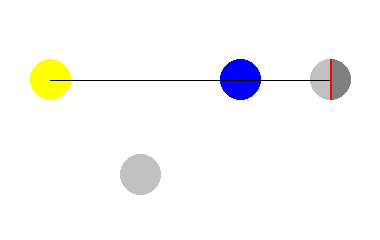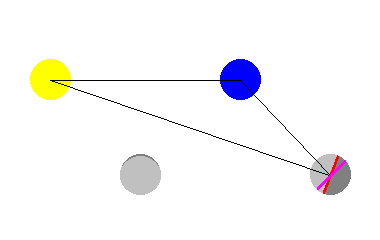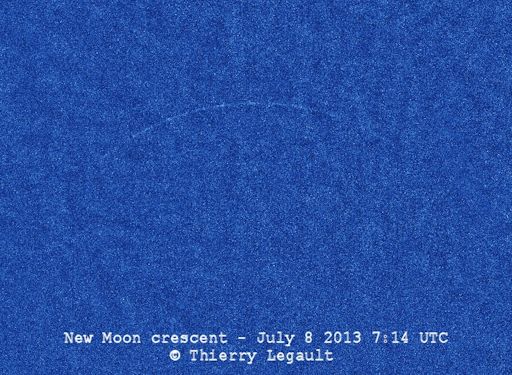

I shall now consider one "explanation" which suffers from a failure to test the hypothesis against the facts: that the "bow" of the crescent Moon does not point at the Sun because the line drawn between the cusps of the crescent as we see it does not represent the true situation, as we are unable to see the actual extent of the terminator [the dividing line between dark and light] because the Moon is almost always sitting out of the plane of the Sun and Earth due to the slight tilt of its orbit relative to the ecliptic. This explanation is tempting, because the basic principle is actually true. The problem is that the extent of the error is exceedingly small!
 | One can demonstrate this by simple geometry. Imagine for a moment the instant of Full Moon, shown "side on" in this [highly exaggerated and not-to-scale!] diagram. The yellow disc represents the Sun, the blue disc the Earth and the grey disc the Moon. The illuminated part of the Moon is shown in light grey, the non-illuminated part in dark grey, separated by the terminator (in red). If the Moon orbited the Earth precisely in the plane of the Earth's orbit around the Sun, at this instant the Sun, Earth and Moon would be in an exact straight line, as in the diagram, and so (if the Earth were transparent!) we would see the entire visible hemisphere of the Moon completely illuminated i.e. the terminator would be effectively invisible, running precisely round the edge of the Moon's visible disc. This appearance is shown at bottom left. The Moon does not orbit in the plane, however: its orbit is inclined at 5deg, so at any given time the Moon can be this much above or below the plane. This means that at Full Moon the three bodies are usually not in an exact straight line (which is why we do not get a lunar eclipse every Full Moon). |
 | If the Moon is below the plane we have the position as shown here. The line defining that part of the Moon which we can see from Earth (shown in pink) will have rotated by the full extent of the current orbital offset i.e. up to 5deg. The change in geometry will also move the position of the terminator, but this movement (exaggerated here) will be very small because of the great distance to the Sun and thus the very small Moon-Sun-Earth angle: I calculate the maximum shift at just over 0.01deg (i.e. negligible). The two lines will thus separate, allowing us to see the northern edge of the terminator, plus some "dark side" beyond, but not the southern edge i.e. the non-illuminated sector between the upper red and pink lines is now visible but the illuminated sector between the lower red and pink lines is not, resulting in the view again shown to bottom left. The situation would clearly be reversed if the Moon were above the plane: we could now see the southern edge of the terminator, plus a bit beyond, but not the northern edge. |
I could repeat the analysis for the case of New Moon, but I think it is clear that the observed result would be the same as for Full Moon, except that one would see a dark Moon edged by a sliver of light rather than a light Moon edged by a sliver of darkness. This idea will be true at any phase, not just Full or New Moon, meaning that, to an observer on the Earth, there will always be a bit of the disc of the Moon which is non-illuminated (and therefore not visible) which a simple in-plane diagram would show as fully visible, or vice-versa. This bit will always be close to the upper or lower margin and therefore will affect the shape of any crescent cusp also present. It is thus correct to say that a projection at 90deg from a line through the visible cusps of a crescent Moon will not necessarily accurately represent the "pointing direction" of the actual fully-illuminated hemisphere. However! This effect is very small indeed. I said above that the maximum amount the terminator moves away from the "line of visibility" is 5deg. This is a 5deg rotation measured at the centre of the Moon though. We see the Moon as a 2D object and so we need to calculate how much the terminator will retreat away from the Moon's limb for a 5deg rotation of its plane. This is (1-cos 5deg), or just 0.38%, of its semi-diameter! As the Moon appears to be about 30 arc-minutes wide this corresponds to a mere 3.4 arc-seconds.
 | These results should be compared to this picture taken from the Spaceweather.com website which shows a picture of New Moon. This should be impossible but, as mentioned above, for the same reason as a Full Moon that is not a lunar eclipse is not perfectly bright, a New Moon that is not a solar eclipse is not perfectly dark. Putting the date and time of the picture into my planetarium program gives a separation from the ecliptic of -5deg and a disc illumination of 0.19% (of its full diameter). The text accompanying the picture notes the thin crescent as being "just a few arc-seconds" wide. QED, I think. |
Calculating the magnitude of the effect for a non-Full (or non-New) Moon is more complicated, as the Sun-Earth-Moon line is now not only "bent" but also "leaning over". However, a consideration of the geometry should convince you that there will be no effect at First Quarter or Last Quarter. In these cases the line of the terminator is at right angles to the line of visibility and so they will not change their relative orientation if the Moon is moved out of the plane. We may thus say that at no time will the effect be greater than at Full or New Moon: from First Quarter through Full to Last Quarter the "sliver" is dark and from Last Quarter through New to First Quarter the sliver is bright.
So, as initially stated, while the theory behind the "explanation" is correct, its magnitude is so small that the explanation itself is fallacious.
Before ending this section there are a couple of side-issues I think it would be interesting to address. Firstly libration. Because the Moon's spin axis is fixed in space the orientation of the Moon does not change as it traverses its orbit, or as the orbit as a whole rotates around the Earth (a process called precession). This means that the part of the Moon which an observer can see "beyond the terminator" (as described above) is not always the same part: it depends on where the Moon is on its orbit at that instant. Therefore, over time, an observer will be able see a total of more than 50% of the Moon's surface (though only a particular 50% at any given time of course!). This effect is called "libration in latitude", and is one of the three reasons we can see more than half of the Moon's total surface area. The other two causes are "libration in longitude" and "diurnal libration". The former happens because although the Moon's spin rotation speed is constant its speed on its eccentric orbit is not: this means that the axial rotation sometimes lags behind the orbital position and sometimes leads it, allowing an observer to see extra area in the equatorial regions. Diurnal libration is a consequence of the slightly different views an observer has of the Moon as it rises and as it sets: at Moon-rise one can see slightly round the "leading edge"; at Moon-set round the trailing edge. There is a similar effect produced by observing from the north and south poles: at the north pole one sees slightly round the "top" of the Moon, and round the "bottom" from the south pole. Libration in latitude amounts to 6.69deg (5.15deg from the orbital tilt, 1.54deg from the axial tilt); libration in longitude is 7.9deg; diurnal/polar libration is about 1deg. Taken together, librations allow us to see a total of 59% of the Moon's surface.
Secondly, the fact that the percentage illumination includes a (highly non-linear) cosine factor is the reason that the Moon appears to be a crescent for a long time and then suddenly rushes towards half-phase: the first 22.5deg rotation of the terminator plane (in 1.85 days) produces just a 4% illumination, the next produces a further 11%, the next 16% and the final one 19%. Or, to put it another way, it takes twice as long for the Moon to go from new to 25% illuminated as it does to go from 25% to half-phase (50% illuminated).